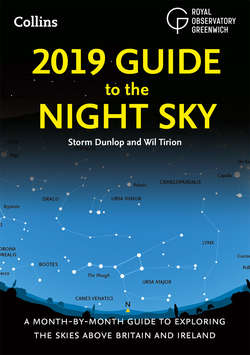Читать книгу 2019 Guide to the Night Sky: Bestselling month-by-month guide to exploring the skies above Britain and Ireland - Wil Tirion - Страница 6
ОглавлениеThe Northern Circumpolar Constellations
The northern circumpolar stars are the key to starting to identify the constellations. For anyone in the northern hemisphere they are visible at any time of the year, and nearly everyone is familiar with the seven stars of the Plough – known as the Big Dipper in North America – an asterism that forms part of the large constellation of Ursa Major (the Great Bear).
Ursa Major
Because of the movement of the stars caused by the passage of the seasons, Ursa Major lies in different parts of the evening sky at different periods of the year. The diagram below shows its position for the four main seasons. The seven stars of the Plough remain visible throughout the year anywhere north of latitude 40°N. Even at the latitude (50°N) for which the charts in this book are drawn, many of the stars in the southern portion of the constellation of Ursa Major are hidden below the horizon for part of the year or (particularly in late summer) cannot be seen late in the night.
Polaris and Ursa Minor
The two stars Dubhe and Merak (α and β Ursae Majoris, respectively), farthest from the ‘tail’ are known as the ‘Pointers’. A line from Merak to Dubhe, extended about five times their separation, leads to the Pole Star, Polaris, or α Ursae Minoris. All the stars in the northern sky appear to rotate around it. There are five main stars in the constellation of Ursa Minor, and the two farthest from the Pole, Kochab and Pherkad (β and ϒ Ursae Minoris, respectively), are known as ‘The Guards’.
Cassiopeia
On the opposite of the North Pole from Ursa Major lies Cassiopeia. It is highly distinctive, appearing as five stars forming a letter ‘W’ or ‘M’ depending on its orientation. Provided the sky is reasonably clear of clouds, you will nearly always be able to see either Ursa Major or Cassiopeia, and thus be able to orientate yourself on the sky.
To find Cassiopeia, start with Alioth (ε Ursae Majoris), the first star in the tail of the Great Bear. A line from this star extended through Polaris points directly towards ϒ Cassiopeiae, the central star of the five.
Cepheus
Although the constellation of Cepheus is fully circumpolar, it is not nearly as well-known as Ursa Major, Ursa Minor or Cassiopeia, partly because its stars are fainter. Its shape is rather like the gable end of a house. The line from the Pointers through Polaris, if extended, leads to Errai (ϒ Cephei) at the ‘top’ of the ‘gable’. The brightest star, Alderamin (α Cephei) lies in the Milky Way region, at the ‘bottom right-hand corner’ of the figure.
Draco
The constellation of Draco consists of a quadrilateral of stars, known as the ‘Head of Draco’ (and also the ‘Lozenge’), and a long chain of stars forming the neck and body of the dragon. To find the Head of Draco, locate the two stars Phecda and Megrez (ϒ and δ Ursae Majoris) in the Plough, opposite the Pointers. Extend a line from Phecda through Megrez by about eight times their separation, right across the sky below the Guards in Ursa Minor, ending at Grumium (ξ Draconis) at one corner of the quadrilateral. The brightest star, Eltanin (ϒ Draconis) lies farther to the south. From the head of Draco, the constellation first runs northeast to Altais (δ Draconis) and ε Draconis, then doubles back southwards before winding its way through Thuban (α Draconis) before ending at λ Draconis between the Pointers and Polaris.
The stars and constellations inside the circle are always above the horizon, seen from our latitude.
The path of comet 46P/Wirtanen from January 1 to March 3, 2019.
The chart above shows stars down to magnitude 8.5 and the chart on the left shows stars to magnitude 10.0.
Comet C/2014 Q2 Lovejoy, which reached naked-eye visibility, photographed on 20 December 2014, when in Columba, by Damian Peach.
